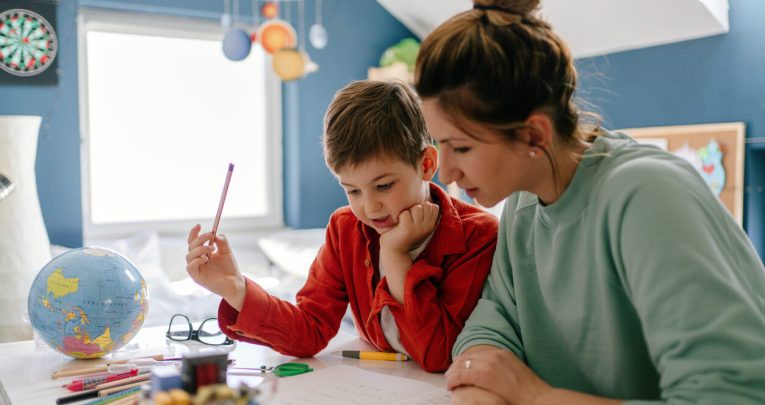How to take the stress out of home learning

Home learning doesn’t have to feel like school, and with these games and activities reading, writing and spelling will barely feel like work, say Christine Chen and Lindsay Pickton…

- by Lindsay Pickton and Christine Chen
- Authors, resource creators and co-founders of Primary Education Advisors Visit website

Getting the right balance of experience for children learning at home has always been tricky; there’s always the potential niggling belief that, like medicine, if it doesn’t taste bad, it isn’t working…
While certain aspects of primary English require grit and application, we believe that a great deal can be learned through a playful, joyful approach – and this can help parents and carers as much as children!
When looking at home-learning, we think there are three things that are worth bearing in mind:
- It shouldn’t (and probably can’t) feel the same as school
- Children’s learning mustn’t be entirely screen-based
- Not all children have parents who are in a position to help them.
We think it’s possible to deal with all of these points and create home-learning that is extremely educationally beneficial, yet barely feels like work.
Here, we suggest just a sample of activities that will help children develop skills within different aspects of writing: spelling; handwriting; vocabulary, grammar and punctuation; and story ideas / structure.
Many of them may feel familiar – the sorts of things we may have done as children, and that some children may even be doing at home as a matter of course. We have attempted to describe them in enough detail to be effective, while also keeping them loose enough that new and better interpretations may be spun from them, to allow for different ages and backgrounds.
It’s important to remember that home-learning can often feel more intense, and so children will need to learn in shorter bursts of time with brain breaks (though if they become absorbed, let them get on, of course!)
The secret to creative stories
There’s a simple route into children creating stories, and you can decide whether to keep them oral (and maybe practise retelling them), or to record them out loud, or to turn them into writing. The simple route is this.
Take a short-ish story that you know quite well, and split it into ‘chapters’. We like five chapters, as this allows children to use the fingers of one hand to plan the story onto.
Traditional tales are great for this as their structures are fundamental. Here’s an example for Cinderella.
- The invitation
- The Fairy Godmother
- The Ball (leaving the shoe behind)
- The Prince’s Search (for the shoe’s owner)
- The Shoe Fits!
From here, you can then make adaptations to the original story:
- First of all, change the setting (eg your town/ village/ city);
- Next, change the event that everyone wants to go to in Chapter 3 (eg an audition, a football trial, a play, a party);
- After that, come up with reasons your hero can’t go in Chapter 1 (eg doesn’t have the right clothes or transport/ unpleasant sibling…);
- Now decide how these problems will be solved in Chapter 2 (a friendly relative, a gift, a kind teacher…) and then watch how the rest of the story unfolds!
You can take the same structure and change it over and over (as Hollywood writers do!): you can set it in the past or the future, you can allow or disallow magic, you can use characters from other stories, like Jack and the Beanstalk!
Sharpen up spelling
Children can develop a positive attitude to spelling at home through fun word-creation games such as Boggle, Upwords and Bananagrams – all fantastic for improving word building and vocabulary. Keep a dictionary handy for checking, and you’ll get purposeful dictionary work into the bargain! I-spy (with my little eye…) is an old favourite, but try mixing up the use of letters and sounds: “…something that begins with a D,” or, “…something that begins with the sound, /d/.
You can take this old game to a much higher level with “…something ENDING with ____ “ or even, “…something with ___ in the middle”.)
Hangman is a spelling game, of course, but many may feel uncomfortable with getting children drawing an execution! But each of the lines of the gibbet and man is just a ‘life’, and you can create the same number of ‘goes’ with a smiley face: circle, two ears, four hair strands, two eyes, a nose and a smile.
Reading is essential to spelling, and if there are a few high-frequency words that a child struggles with (eg “what”, “when”, “which”, “where”, “said”, “because”…), they could, when reading, notice these and copy them accurately in a special, personalised notebook.
Yoga and handwriting
Handwriting may be broadly separated into motor (involving muscle) control and knowledge of letter joins and movements.
Children can improve fine motor control through fun, physical activities, including model making and crafts!
For example, children might like making very small dinosaurs or other animals (or whatever is of interest) out of clay or plasticine; they might enjoy making Easter and birthday cards, including pop-up ones, that involve drawing intricate patterns, cutting and gluing.
An often-neglected element of handwriting control is core strength, as you have to be able to sit tall and strong to write well. Physical core strength challenges, such as ‘the wheel-barrow’, short holds in ‘plank’ or ‘superman/woman,’ or a few ‘mountain climbers’ are a great way to develop this! (Age-appropriate YouTube workouts, including yoga ones, can often do the trick!)
Playing with grammar
One of our very favourite games for teaching children the sheer joy and potential of language is Grandma’s Chocolate Cake.
You repeat the sentence, “I didn’t eat Grandma’s chocolate cake,” but each time you put emphasis on a different word: “I didn’t eat Grandma’s chocolate cake,” – what did you do with it, then? “I didn’t eat Grandma’s chocolate cake,” – whose cake did you eat, then? And so on.
The key is to talk about the new meaning each time.
Very quickly, children will be able to compose their own sentences using the same sort of pattern: “I didn’t walk to my friend’s house.”
They might also use known stories: “He didn’t walk across the Troll’s bridge”; “Harry didn’t like his new teacher,” or even factual knowledge: “Henry VIII didn’t execute all his wives”!
Similar-but-different to this is Every Word Counts, in which you take a sentence and change individual words within it, noting the different meaning that this creates each time: “She sat on the new bean-bag.” What could you swap the first word for? (– He/ they/ I/ it/ Chris…); The second word? (– leapt/ slept/ bounced/ laughed…); The third? (– beside, across, beneath…); and so on. You can keep each change, or reset to the original sentence each time.
If the sentence has six words – as in the example – you might attach a number to each and use a dice to tell you which word to choose next. It’s not absolutely necessary, but writing down each new sentence – or at least the favourite ones – will help with retention of learning (as well as practise handwriting and spelling!).
Physical punctuation is a great way of learning how punctuation works.
Children listen to a story (or news article or, something from a magazine etc) being read aloud, and they indicate where the capital letters and full stops should go – so place your hand on your head as a ‘cap’ whenever a capital letter is needed, and form a clenched fist to represent a full stop.
The key is that they do this without being able to see the text: they must listen and sense the punctuation.
Once children have mastered this (and not before) they can start indicating the commas – a crooked finger – the question and exclamation marks (a fist with a curved or straight forearm above) and so on. Introduce a new punctuation mark only when the last one is mastered!
Christine Chen and Lindsay Pickton work with schools in the UK and internationally to improve English teaching (primaryeducationadvisors.co.uk). Previously they were lead teachers in primary schools and local authority advisers.










